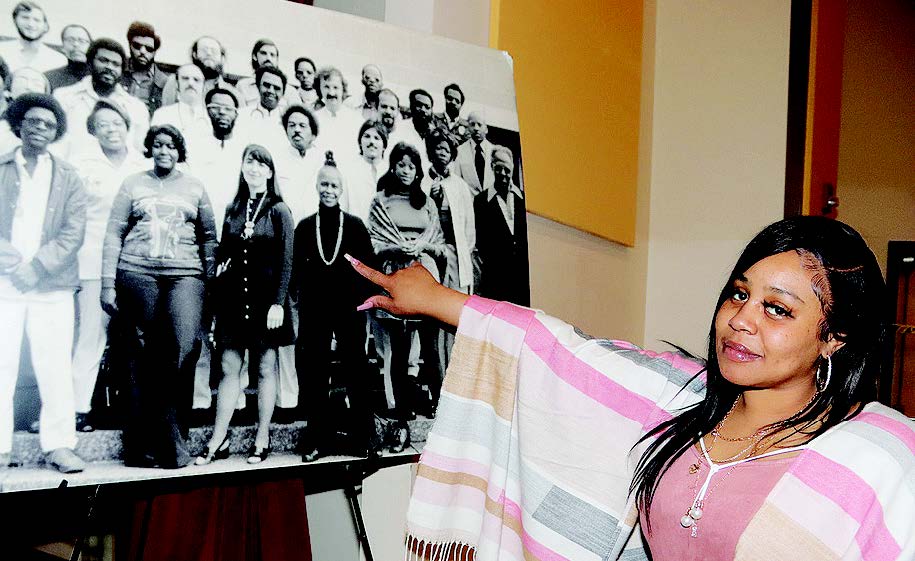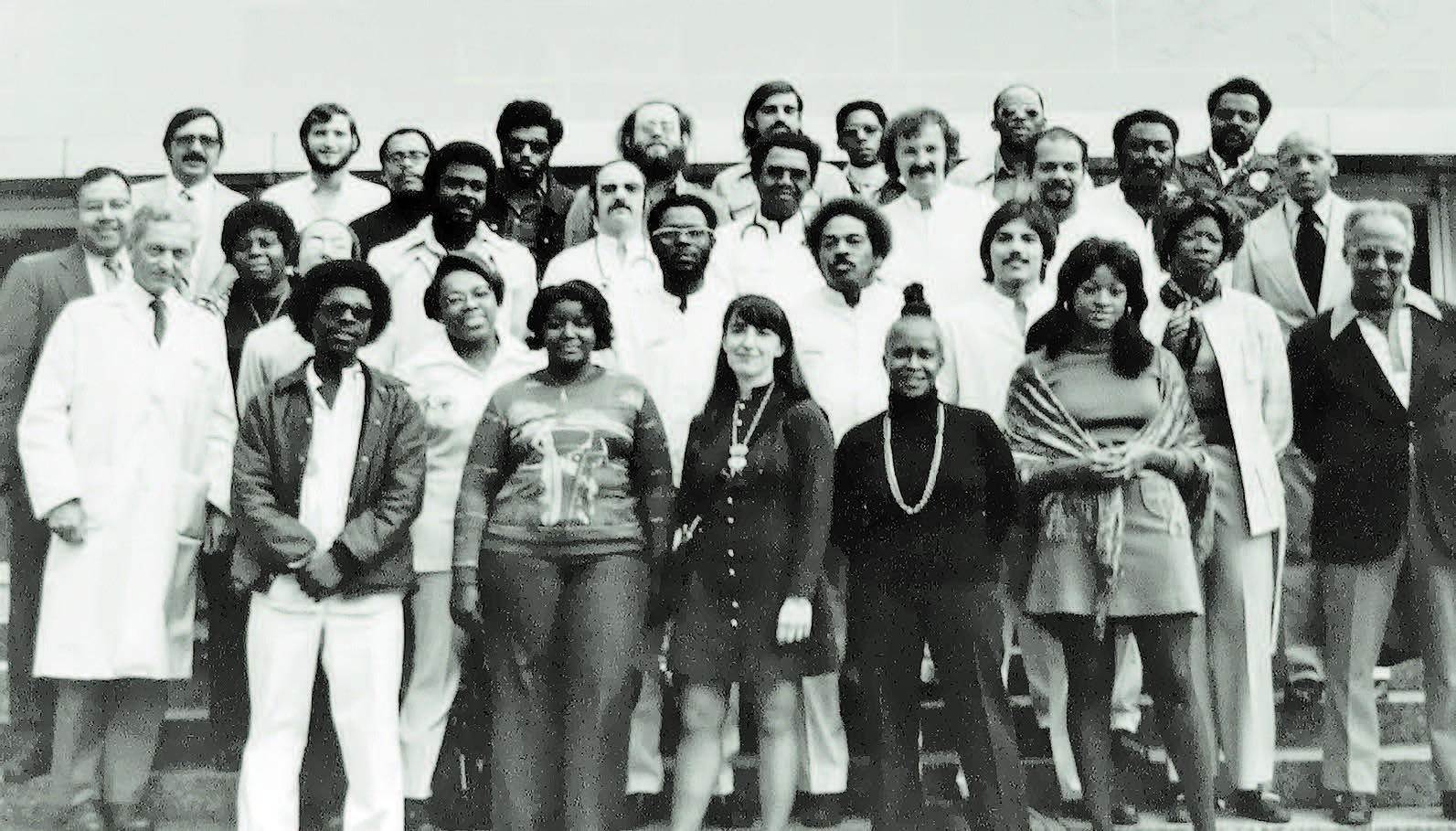PICTURED ARE THE “FREEDOM HOUSE 2.0” GRADUATES—Front row: Tashina Hosey, Shannon Keyes, Vanessa Reddix, Desaray Owens. Back row: Matt Eaker, Christopher Pollock, Elijah Sellers Jr., Zach DiAnderth. (Photo by J.L. Martello)
by Rob Taylor Jr.
Courier Staff Writer
This wasn’t just any graduation ceremony.
This was a graduation ceremony that was worthy of being held in-person, though social distancing measures and masks were worn throughout the affair.
On March 19 at the Hillman Auditorium, inside the ACH Clear Pathways Performing Arts Center in the Hill District, eight individuals graduated from “Freedom House 2.0,” a program that trains those involved with becoming an Emergency Medical Technician. An EMT has become one of the most important professions, as their care could be the difference between a person’s life and death en route to the nearest hospital.
But what makes this program so distinguished, so unique, is that it’s patterned after the original Freedom House Ambulances that would often transport individuals from the Hill District to the hospital in the late 1960s through 1975.
For those too young to remember, there was a time when ambulances weren’t just readily available. The police would respond to a medical emergency, and without the ability to treat the victim, would race the individual to the nearest medical center. Ambulances were run mostly by private companies, and in the racially tense Pittsburgh, private ambulances wouldn’t go to the predominantly-Black Hill District. Still, private ambulances weren’t equipped with individuals who were highly trained in medical care.
But in 1967, a group of individuals, mostly young, Black men, were recruited to study emergency medical treatment, and by the next year, the Freedom House Ambulance Service began, serving people in the Hill. As time progressed, the service and its staff members grew, while also treating people in other city neighborhoods. By 1975, the city decided to establish its own EMT service, dissolving the Freedom House Ambulances.
The Freedom House Ambulance Service medical personnel were, indeed, the nation’s first paramedics.
Now, almost 50 years later, the Freedom House 2.0 graduates, who were majority-Black, underwent a ten-week training session to earn their EMT or similar certifications. The program was sponsored by UPMC, Partner4Work and the Neighborhood Resilience Project. Each graduate was guaranteed a job interview with UPMC, as well.
Faculty members from Pitt’s Emergency Medicine program provided the training and instructional resources. The training focused on traditional emergency medical services and on equipping first-responders to help address critical, non-emergency psychosocial needs—such as poorly managed chronic medical and behavioral health conditions and a lack of access to resources to address them—that comprise a significant portion of 911 calls, according to a Pittwire report.
The program, which began as a way to increase diversity and jumpstart workforce development during the COVID-19 pandemic, is continuing, the New Pittsburgh Courier has learned—a new cohort of individuals has already been selected for a future ten-week training session.
“We’re truly trying to build them a pipeline to whatever they (students) want to be in the future,” Kenneth Hickey, the program’s leader, told Pittwire.

GRADUATE VANESSA REDDIX, who aspires to become a Physician Assistant.
Vanessa Reddix, of the West End, was one of the graduates on March 19, who said she had a passion for helping others. She told the Courier’s J.L. Martello that she’s had 14 surgeries, including brain surgery in September 2018, and she can relate to those individuals who have medical issues.“That’s the whole reason why I want to do my job,” Reddix, 31, a Point Park graduate, said. By obtaining her EMT and paramedic certifications, she’ll be able to cross over into becoming a Physician Assistant. Physician Assistants, on average, earn $108,000 a year, according to the Bureau of Labor Statistics.
Paramedics in Pittsburgh earn a $48,328 base annual salary in their first and second years on the job, the Courier has learned. A third-year city paramedic earns a base annual salary of $55,917, and increases up to $71,327 in the fifth year. Crew Chiefs earn a $76,714 base annual salary. Base annual salaries don’t include overtime, holiday or special event pay rates.

GRADUATE ELIJAH SELLERS JR.
For graduate Elijah Sellers Jr., of Mt. Oliver, he wanted to become an EMT because it’s something “that is very much so required in the world that we live in,” he said. “There are emergencies everywhere, and the amount of people that we currently have to work on those emergencies is very minimal. I would like to be part of the process of rebuilding it and helping out as much as I can, being an inspiration to the next generation of EMTs.”

DESARAY OWENS, a graduate of “Freedom House 2.0” on March 19, points to a photo of her grandmother, Doris Owens, who was a member of the “Freedom House Ambulance Service” of the late 1960s to 1975. (Photos by Courier photographer J.L. Martello)
Graduate Desaray Owens, of Homewood, has the closest connection to the original Freedom House Ambulance Service members in the graduating class. When she opened the brochure detailing the Freedom House 2.0’s objectives, she saw a photo of the some of the original members—and noticed her grandmother, Doris Owens.
“I heard the stories,” Desaray Owens told the Courier. “She inspired me to come in this field as a kid.”
How it all began
Dig deep into the origins of the Freedom House Ambulance Service, and you’ll find Phil Hallen, who in 1967 ran the Maurice Falk Medical Fund, a foundation focused on bringing health care to the poor. Hallen wanted to start a private ambulance service for the Hill District, and was soon introduced to a University of Pittsburgh physician, Dr. Peter Safar. Dr. Safar, who worked at the well-known Presbyterian University Hospital, in Oakland (now UPMC Presbyterian), was on the same page with Hallen. However, according to a 2011 Pitt report on its Department of Anesthesiology and Perioperative Medicine website, Dr. Safar was “constantly halted by roadblocks when negotiating with local organizations for a grant to standardize emergency services in Allegheny County. Physicians felt only they were qualified to provide medical care. Allegheny County volunteer firemen resented having paramedics in ambulances take training and feared they would be put out of business. The mayor passed the buck, claiming emergency services were a county responsibility.”
That’s when, according to the Pitt report, the two men recruited James McCoy Jr., founder of the Hill District’s Freedom House Enterprise Corporation, and Morton Coleman, an aide to the Pittsburgh mayor and part-time social work professor at Pitt. Within weeks, the Freedom House Ambulance Service Committee held its first meeting in April 1967, and later, the young, Black men were recruited (women later joined) for the ambulance service in the Hill.
…where the ‘Freedom House Ambulance Service’ originated more than 50 years ago

A PHOTO OF SOME OF THE ORIGINAL MEMBERS of the “Freedom House Ambulance Service,” which was created in 1968 to provide emergency medical services via ambulance to Black residents in the Hill District. The service was so highly regarded, it led to the City of Pittsburgh creating its Emergency Medical Services division in 1975. (Photo courtesy University of Pittsburgh)
According to the Pitt report, Freedom House Ambulance Service made 5,868 runs and transported 4,627 patients in its first year, responding to an average of 15 calls a day, with a DOA (dead on arrival) record of only 1.9 percent. “More than 50 Freedom House paramedics and dispatchers handled more than 45,000 emergency calls over their eight-year history,” the 2011 Pitt report read. “They were no longer running second-hand donated police ambulances, but five mobile intensive care ambulances.”
Who knew that Hallen and Dr. Safar’s idea would turn into an entirely new profession? Who knew that the African Americans and others who were so closely instrumental in providing their medical services back then would become iconic today?

JOHN MOON points to himself in the photo of some of the members of the “Freedom House Ambulance Service.” Moon began with the service in 1972 as a paramedic, later rising to assistant crew chief. (Photo by Courier photographer J.L. Martello)
John Moon is one of those iconic figures. He was a member of the group of young, Black men who joined the Freedom House Ambulance Service. He was omnipresent at the Freedom House 2.0 graduation ceremony on March 19, in the Hill District, familiar territory for Moon.
Amera Gilchrist, who currently serves as Deputy Chief of Pittsburgh Emergency Medical Services, said bluntly that “if it wasn’t for him (John Moon), I wouldn’t be here.”
Gilchrist, who is African American, has been with the city for 22 years as a paramedic.

GRADUATE DESARAY OWENS, center, with “Freedom House Ambulance Service” member John Moon, left, and Deputy Chief of Pittsburgh EMS Amera Gilchrist. (Photo by Courier photographer J.L. Martello)
About the graduating class, Moon told the Courier that they have “a tremendous opportunity to get into the pre-hospital arena because the foundation has already been laid.” The graduates can lean on Gilchrist or Moon as mentors, are already on the inside track with UPMC, and will soon be able to ride with a Pittsburgh EMS unit.
Moon said that “people often think that the faster you get them to the Emergency Room, the better they’ll be. Statistics have shown, and the Freedom House Ambulance Service stats showed, that it’s not how fast you get there; it’s what’s being done for them before they get to the Emergency Room. This group will get an opportunity to actually see (what happens) prior to that person getting to the E.R.”
Moon said he went from Freedom House Ambulance Service paramedic in 1972 to assistant crew chief of the group in one year. He remained in that position until the service dissolved in 1975. Moon retired in 2009 as assistant chief of the Pittsburgh EMS, known for his tireless efforts to diversify the EMS division in Pittsburgh.
“I definitely owe a deep debt of gratitude to Freedom House Ambulance Service and it’s my belief that the nation owes a deep debt of gratitude to Freedom House Ambulance Service, its mere existence,” Moon told the Courier’s J.L. Martello exclusively at the March 19 event. “For what we did, what we designed, the training, every EMS system in this country is built off our foundation…a group of individuals that society said would be the least likely to succeed; unemployable; society’s throwaways…in spite of all those objections, barriers and trials that we had to go through from a political, economic and racial standpoint, we were able to leave a legacy that I hope will remain in history forever.”